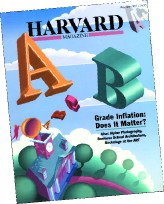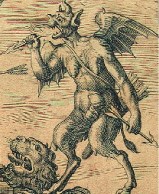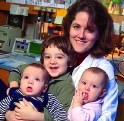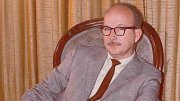WHEN GRADE INFLATION DID NOT BEGIN
 |
| Eight years ago this magazine gave major coverage to what seemed the burgeoning of grade inflation ("Desperately Seeking Summa," May-June 1993, page 36). Now the dean of the College says there's nothing new about the phenomenon, which "seems to have been considered a problem for as long as there have been grades." |
Harry R. Lewis '68, Ph.D. '74
McKay professor of computer science
Dean of Harvard College
Cambridge
OUT-OF-COUNTRY EXPERIENCES
Hats off to Elizabeth Gudrais '01 for promoting study abroad ("The Undergraduate," March-April, page 70). As many who have done so can attest, the value of experience gained overseas cannot be overestimated.
Twenty years ago, I was hustling with a concentration in history and literature between the Germanic languages and literatures and the history departments to arrange for my junior year in West Germany. Each faculty member and administrator was encouraging and supportive. So long as I found an acceptable program that met their criteria and was willing to do all the legwork, they urged me on.
I joined some 40 other juniors from across the country in a program sponsored by Wayne State University. The year was better than I ever expected. Formalizing study abroad would only enrich the Harvard experience for all.
Stephen J. Keeler '83
Erial, N.J.
ENTANGLED ABOUT MARIJUANA
It strikes me that there is no such thing as an objective opinion about marijuana, medical or otherwise ("Harvard Health," March-April, page 26). Most official research of the past 30 years has been devoted to locating its dangers, and to some degree has found what it sought; what's beneficial about it remains "anecdotal," and there are millions of anecdotes.
Marijuana use, like it or not, is a political issue, deeply entangled with a person's take on the countercultural upheaval of that decade-straddling era conveniently mislabeled the Sixties. Those who viewed the time as a joyous assault on cultural repression made leafy little cannabis a symbol of liberatory psychic forces inaccessible to mere rationality; defenders of the psychosocial status quo continue to see it as the satanic pimp of anarchy and chaos. Caught in the middle are actual sick people whose comfort and well-being are daily sacrificed to the agenda of those who demonize pot not for what it does, but what it represents. Why else would Bruce Wexler ("Letters," May-June, page 4), like so many others, flap his alarm for minds "compromised by marijuana use," but apparently tolerate the vastly greater damage done at every level of society by alcohol abuse?
Many of the most talented and successful members of my generation in business, the professions, media, academia, and the arts are happily familiar with marijuana's benefits, and only the menace of prohibition ties their tongues. Place on one side all fears of the herb's harmful effects, and the balance still shifts decisively to the side where we encounter Louis Armstrong wreathed in smoke.
Stephen Hanan '68
New York City
CIVIL WAR SLAUGHTER
"The Deadliest War" (May-June, page 15) was fascinating, but appears to contain two statistical errors. I would guess that the death rate of Americans in World War II was closer to 30 per 1,000 than "30 out of every 10,000 men in uniform" and the death rate during the Civil War was closer to 182 per 1,000 than "182 per 10,000." While the extra zeros have little impact on the printed page, they paint a drastically different picture of the mortality rates during the two wars.
R.W. Leyden, J.D. '72
Stamford, Conn.
Editor's note: The numbers given in the article are accurate, but they properly refer not to "men in uniform," as stated, but to the entire population of men, women, and children.
PERVASIVE LEFT-HANDED DNA
The stylized DNA model depicted on page 76 of the May-June issue to illustrate "Genomic Science and Society" has a left-handed helical twist. Normal DNA has a right-handed helical twist. If viewed in a mirror, this image shows the correct right-handed twist. Left-handed DNA has pervaded the media recently, showing up on covers of national magazines, in leading newspaper articles, and in movies.
Hidong Kim, Ph.D. '93
Bainbridge Island, Wash.
NAUGHTY DEED GOES UNPUNISHED (EVIDENTLY)
 |
| Satan, from the frontispiece of The Christian Warfare, the only one of John Harvard's books known to have survived the fire of 1764. Did the devil get into Ephraim Briggs? |
David Otis Fuller Jr., J.D. '64
Tuckahoe, N.Y.
Editor's note: David R. Whitesell, a rare book cataloger at Harvard's Houghton Library, who had uncovered Briggs's name for this magazine, says "the expulsion story is one I've never encountered, and it sounds like a fable of recent manufacture. I've rechecked Sibley's Harvard Graduates (volume 16, page 30), where there is no mention of Briggs not having graduated with his class (i.e. in 1764), and he proceeded to an M.A. as was usual at the time. Given the apparent laxity in policing library circulation in his day, it seems very unlikely that Briggs was punished in any way for failing to return the book on time. If he had been, a significant percentage of the senior class would have deserved punishment, too."
NEW-STYLE PHILANTHROPISTS
Venture philanthropists ("Philanthropy in a New Key," May-June, page 39) might have the best intentions in the world, but what are they about, really? Sounds like ego-gratification to me. If they sincerely want to make a difference in this country, they could volunteer to pay more taxes, and then lobby for humane budget priorities and sensible regulations. The plain fact is that only national government has the scope and resources to deal with poverty and other major social problems in anything other than a piecemeal, scattershot, and ultimately ineffective fashion.
One of the public purposes of the nonprofit sector is to give charities a chance to develop small innovative programs. If the programs are shown to work, the next step should be to persuade government to take the models to scale. Few philanthropists seem willing to tackle this transition. Instead, they claim bragging rights to programs that work, and feel free to drop the ones that no longer fit the giving trend of the moment. Kids in one neighborhood near (probably not too near) the donor might benefit from a new after-school program, but until people insist that such services be available to all children, that program is just another rich person's toy.
Kennedy School assistant professor Peter Frumkin is quoted as saying, "The best giving comes when the underlying concern is a personal one. It comes from the interests and values of the donor." My question is, what about the values of the non-rich among us? As more and more services are shunted from government to nonprofits, will it be up to the rich to decide what gets funded and what falls by the wayside? Will the cute causes be snapped up by philanthropists and the scruffy ones be left for the taxpayers?
I'm all for the rich getting involved in service provision. If they can offer provider organizations some guidance toward efficient management, that's great. But I have a feeling that most philanthropists who dare to serve people directly will find that they have more to learn than to teach.
Jane Sass Collins '71
Medford, Mass.
LETHAL LANGUAGE
Compare two articles on two outstanding women hockey players: Andrea Kilbourne, Princeton '02, portrayed in "Ice-cold 'Killer'" (Princeton Alumni Weekly, December 20, 2000) and Jennifer Botterill '02 in "The Unstoppable Botterill" (Harvard Magazine, January-February, page 80).
Kilbourne is described as an "assassin" and "lethal weapon" by writer Patrick Sullivan and as a "humble, gracious player [with a] 'killer instinct'" by her Princeton coach Jeff Kampersal.
Botterill's Harvard coach Katey Stone describes her as "the best skater in the world" and "poetry in motion on the ice," as reported by writer Craig Lambert--with nary a lethal reference if we except "sudden death" and "explosive."
We have become sensitive to avoiding racist and sexist language, but we still speak and write the language of lethality with seeming unconcern whilst lamenting the violence of American society and the world. To call killing "killing" when it is real, is a service to society. When we employ the language of lethality gratuitously, it is not.
This is the first year of the "UN International Decade for a Culture of Peace and Nonviolence for the Children of the World (2001-2010)," although the media have scarcely taken notice of it and may not do so for the decade. Nevertheless, it is a good time to think about what contributions we are making to cultures of violence and what alternative contributions we might make to strengthening powerful cultures of nonviolence.
Glenn D. Paige, M.A. '57
President, Center for Global Nonviolence
Honolulu
ABOUT A WORLD COMMUNITY
In his letter in the January-February issue (page 11), John L. Shurtleff '46 bemoans the call of Molly Hennessy-Fiske '99 to destroy nuclear bombs ("Letters," November-December 2000, page 6). "We would not be serving the 'struggle for a truly free world' if we beat our swords into plowshares," he writes, "unless and until we have an effective world government strong enough to keep the peace."
Surely, Shurtleff need have no fears that we shall beat our swords into plowshares. What nuclear power is likely to give up its deadliest, most cherished, weapon? The great moral leader of the "free world" won't even give up its land mines.
Both Hennessy-Fiske and Shurtleff are partly right--Shurtleff for pointing to the only reliable basis for global disarmament, and Hennessy-Fiske for calling for an immediate abolition of these weapons of destruction.
To bring about a world community, a major value shift by a critical mass of the world's electorates is required. A successful world-unity movement would have to become the greatest social movement in history. Turn to the grassroots, whence all great movements have sprouted. Suppose a few youth (or others) felt so strongly the need for an unarmed community that they publicly announced that under no circumstances would they accept recruitment or conscription into any military. Nor would they participate in any action to honor any military action, rank, or symbol. Further, they would refrain from honoring or glorifying any armed nation and its symbols. Instead, they would display symbols of the world, identifying themselves as primarily world citizens.
Imagine these same nonviolent revolutionaries recruiting other young people. They urge them to despise all weapons. They approach schools and churches with their appeal for commitment to an ethically and morally superior, life-caring world community. Organized into small groups, they network--locally, regionally, nationally, and internationally.
Disarmament at the grassroots, presenting a life-caring world community as the alternative to violently competing sovereign nations, answers the concerns of both Hennessy-Fiske and Shurtleff.
Guy W. Meyer '35
Inverness, Calif.
MORE HARVARD BEATS YALE
Regarding the letter of mine about Harvard's 1968 29-29 "victory" over Yale ("Letters," March-April, page 10), please let the record show that the primary claim I am making is simply this: that I am the person who spoke to Crimson photographer Tim Carlson '71 on the football field after the game, asked if he worked for the Crimson, and told him to publish the now-famous headline. Since no one else has stepped forward to claim that they also spoke to Carlson on the field that day, I would like the record to reflect my supporting role in enabling the memorable headline.
William J. Clark '66
Greenwich, Conn.
One last footnote to that game. I was the Newsweek guy in the press box, sitting next to the legendary Red Smith, then with the New York Times. We had a nice chat throughout, and he left in the middle of the fourth quarter, saying he had to catch a shuttle and to call him if anything happened. Post-game, I called him from a phone booth in Harvard Square (pre-cell phones) and said Harvard had tied it up in the final 42 seconds. Literally, stunned silence. Quoth he, "One of the great comebacks in my time writing sports and I missed it!"
Also, Vic Gatto, wherever you are, before The Game you said "Newsweek asked me if I thought Dowling was a God." Someone else must have asked you that, not me, but that's how titanic the lead-up to the match was. Incidentally, how many current Harvardians know who "B.D." is in Mr. Jane Pauley's comic strip?
Frank Morgan
Hawi, Hawaii
SPEAK UP, PLEASE
Harvard Magazine welcomes letters on its contents. Please write to "Letters," Harvard Magazine, 7 Ware Street, Cambridge 02138, or send comments by facsimile to 617-495-0324, or by e-mail to yourturn@harvard.edu, or use our Internet site, www.harvard-magazine.com. Letters may be edited to fit the available space.
ERRATA, AMPLIFICATION, PUZZLEMENTS
In the article on President-elect Lawrence H. Summers ("A Worldly Professor," May-June, page 30), reference was made to a profile in the Boston Globe's Sunday magazine in 1986 (not 1985, as printed). The profile's author, Eve LaPlante, Ed.M. '92, a writer from Brookline, Massachusetts, was inadvertently not credited.
 |
| Patti and her children in her lab at Joslin Diabetes Center |
| Photograph by Jim Harrison |
Grove Harris, the Wiccan priestess who spoke at morning prayers ("The College Pump," May-June, page 92) was identified as administrative assistant of the Pluralism Project. She is now project manager there.
Caroline Bynum, Ph.D. '69, who chaired the Radcliffe Institute's advisory committee ("Radcliffe Consults Its Compass," May-June, page 62), is also a member of the class of '62.
The editors regret these f
WHEN GRADE INFLATION DID NOT BEGIN
 |
| Eight years ago this magazine gave major coverage to what seemed the burgeoning of grade inflation ("Desperately Seeking Summa," May-June 1993, page 36). Now the dean of the College says there's nothing new about the phenomenon, which "seems to have been considered a problem for as long as there have been grades." |
Harry R. Lewis '68, Ph.D. '74
McKay professor of computer science
Dean of Harvard College
Cambridge
OUT-OF-COUNTRY EXPERIENCES
Hats off to Elizabeth Gudrais '01 for promoting study abroad ("The Undergraduate," March-April, page 70). As many who have done so can attest, the value of experience gained overseas cannot be overestimated.
Twenty years ago, I was hustling with a concentration in history and literature between the Germanic languages and literatures and the history departments to arrange for my junior year in West Germany. Each faculty member and administrator was encouraging and supportive. So long as I found an acceptable program that met their criteria and was willing to do all the legwork, they urged me on.
I joined some 40 other juniors from across the country in a program sponsored by Wayne State University. The year was better than I ever expected. Formalizing study abroad would only enrich the Harvard experience for all.
Stephen J. Keeler '83
Erial, N.J.
ENTANGLED ABOUT MARIJUANA
It strikes me that there is no such thing as an objective opinion about marijuana, medical or otherwise ("Harvard Health," March-April, page 26). Most official research of the past 30 years has been devoted to locating its dangers, and to some degree has found what it sought; what's beneficial about it remains "anecdotal," and there are millions of anecdotes.
Marijuana use, like it or not, is a political issue, deeply entangled with a person's take on the countercultural upheaval of that decade-straddling era conveniently mislabeled the Sixties. Those who viewed the time as a joyous assault on cultural repression made leafy little cannabis a symbol of liberatory psychic forces inaccessible to mere rationality; defenders of the psychosocial status quo continue to see it as the satanic pimp of anarchy and chaos. Caught in the middle are actual sick people whose comfort and well-being are daily sacrificed to the agenda of those who demonize pot not for what it does, but what it represents. Why else would Bruce Wexler ("Letters," May-June, page 4), like so many others, flap his alarm for minds "compromised by marijuana use," but apparently tolerate the vastly greater damage done at every level of society by alcohol abuse?
Many of the most talented and successful members of my generation in business, the professions, media, academia, and the arts are happily familiar with marijuana's benefits, and only the menace of prohibition ties their tongues. Place on one side all fears of the herb's harmful effects, and the balance still shifts decisively to the side where we encounter Louis Armstrong wreathed in smoke.
Stephen Hanan '68
New York City
CIVIL WAR SLAUGHTER
"The Deadliest War" (May-June, page 15) was fascinating, but appears to contain two statistical errors. I would guess that the death rate of Americans in World War II was closer to 30 per 1,000 than "30 out of every 10,000 men in uniform" and the death rate during the Civil War was closer to 182 per 1,000 than "182 per 10,000." While the extra zeros have little impact on the printed page, they paint a drastically different picture of the mortality rates during the two wars.
R.W. Leyden, J.D. '72
Stamford, Conn.
Editor's note: The numbers given in the article are accurate, but they properly refer not to "men in uniform," as stated, but to the entire population of men, women, and children.
PERVASIVE LEFT-HANDED DNA
The stylized DNA model depicted on page 76 of the May-June issue to illustrate "Genomic Science and Society" has a left-handed helical twist. Normal DNA has a right-handed helical twist. If viewed in a mirror, this image shows the correct right-handed twist. Left-handed DNA has pervaded the media recently, showing up on covers of national magazines, in leading newspaper articles, and in movies.
Hidong Kim, Ph.D. '93
Bainbridge Island, Wash.
NAUGHTY DEED GOES UNPUNISHED (EVIDENTLY)
 |
| Satan, from the frontispiece of The Christian Warfare, the only one of John Harvard's books known to have survived the fire of 1764. Did the devil get into Ephraim Briggs? |
David Otis Fuller Jr., J.D. '64
Tuckahoe, N.Y.
Editor's note: David R. Whitesell, a rare book cataloger at Harvard's Houghton Library, who had uncovered Briggs's name for this magazine, says "the expulsion story is one I've never encountered, and it sounds like a fable of recent manufacture. I've rechecked Sibley's Harvard Graduates (volume 16, page 30), where there is no mention of Briggs not having graduated with his class (i.e. in 1764), and he proceeded to an M.A. as was usual at the time. Given the apparent laxity in policing library circulation in his day, it seems very unlikely that Briggs was punished in any way for failing to return the book on time. If he had been, a significant percentage of the senior class would have deserved punishment, too."
NEW-STYLE PHILANTHROPISTS
Venture philanthropists ("Philanthropy in a New Key," May-June, page 39) might have the best intentions in the world, but what are they about, really? Sounds like ego-gratification to me. If they sincerely want to make a difference in this country, they could volunteer to pay more taxes, and then lobby for humane budget priorities and sensible regulations. The plain fact is that only national government has the scope and resources to deal with poverty and other major social problems in anything other than a piecemeal, scattershot, and ultimately ineffective fashion.
One of the public purposes of the nonprofit sector is to give charities a chance to develop small innovative programs. If the programs are shown to work, the next step should be to persuade government to take the models to scale. Few philanthropists seem willing to tackle this transition. Instead, they claim bragging rights to programs that work, and feel free to drop the ones that no longer fit the giving trend of the moment. Kids in one neighborhood near (probably not too near) the donor might benefit from a new after-school program, but until people insist that such services be available to all children, that program is just another rich person's toy.
Kennedy School assistant professor Peter Frumkin is quoted as saying, "The best giving comes when the underlying concern is a personal one. It comes from the interests and values of the donor." My question is, what about the values of the non-rich among us? As more and more services are shunted from government to nonprofits, will it be up to the rich to decide what gets funded and what falls by the wayside? Will the cute causes be snapped up by philanthropists and the scruffy ones be left for the taxpayers?
I'm all for the rich getting involved in service provision. If they can offer provider organizations some guidance toward efficient management, that's great. But I have a feeling that most philanthropists who dare to serve people directly will find that they have more to learn than to teach.
Jane Sass Collins '71
Medford, Mass.
LETHAL LANGUAGE
Compare two articles on two outstanding women hockey players: Andrea Kilbourne, Princeton '02, portrayed in "Ice-cold 'Killer'" (Princeton Alumni Weekly, December 20, 2000) and Jennifer Botterill '02 in "The Unstoppable Botterill" (Harvard Magazine, January-February, page 80).
Kilbourne is described as an "assassin" and "lethal weapon" by writer Patrick Sullivan and as a "humble, gracious player [with a] 'killer instinct'" by her Princeton coach Jeff Kampersal.
Botterill's Harvard coach Katey Stone describes her as "the best skater in the world" and "poetry in motion on the ice," as reported by writer Craig Lambert--with nary a lethal reference if we except "sudden death" and "explosive."
We have become sensitive to avoiding racist and sexist language, but we still speak and write the language of lethality with seeming unconcern whilst lamenting the violence of American society and the world. To call killing "killing" when it is real, is a service to society. When we employ the language of lethality gratuitously, it is not.
This is the first year of the "UN International Decade for a Culture of Peace and Nonviolence for the Children of the World (2001-2010)," although the media have scarcely taken notice of it and may not do so for the decade. Nevertheless, it is a good time to think about what contributions we are making to cultures of violence and what alternative contributions we might make to strengthening powerful cultures of nonviolence.
Glenn D. Paige, M.A. '57
President, Center for Global Nonviolence
Honolulu
ABOUT A WORLD COMMUNITY
In his letter in the January-February issue (page 11), John L. Shurtleff '46 bemoans the call of Molly Hennessy-Fiske '99 to destroy nuclear bombs ("Letters," November-December 2000, page 6). "We would not be serving the 'struggle for a truly free world' if we beat our swords into plowshares," he writes, "unless and until we have an effective world government strong enough to keep the peace."
Surely, Shurtleff need have no fears that we shall beat our swords into plowshares. What nuclear power is likely to give up its deadliest, most cherished, weapon? The great moral leader of the "free world" won't even give up its land mines.
Both Hennessy-Fiske and Shurtleff are partly right--Shurtleff for pointing to the only reliable basis for global disarmament, and Hennessy-Fiske for calling for an immediate abolition of these weapons of destruction.
To bring about a world community, a major value shift by a critical mass of the world's electorates is required. A successful world-unity movement would have to become the greatest social movement in history. Turn to the grassroots, whence all great movements have sprouted. Suppose a few youth (or others) felt so strongly the need for an unarmed community that they publicly announced that under no circumstances would they accept recruitment or conscription into any military. Nor would they participate in any action to honor any military action, rank, or symbol. Further, they would refrain from honoring or glorifying any armed nation and its symbols. Instead, they would display symbols of the world, identifying themselves as primarily world citizens.
Imagine these same nonviolent revolutionaries recruiting other young people. They urge them to despise all weapons. They approach schools and churches with their appeal for commitment to an ethically and morally superior, life-caring world community. Organized into small groups, they network--locally, regionally, nationally, and internationally.
Disarmament at the grassroots, presenting a life-caring world community as the alternative to violently competing sovereign nations, answers the concerns of both Hennessy-Fiske and Shurtleff.
Guy W. Meyer '35
Inverness, Calif.
MORE HARVARD BEATS YALE
Regarding the letter of mine about Harvard's 1968 29-29 "victory" over Yale ("Letters," March-April, page 10), please let the record show that the primary claim I am making is simply this: that I am the person who spoke to Crimson photographer Tim Carlson '71 on the football field after the game, asked if he worked for the Crimson, and told him to publish the now-famous headline. Since no one else has stepped forward to claim that they also spoke to Carlson on the field that day, I would like the record to reflect my supporting role in enabling the memorable headline.
William J. Clark '66
Greenwich, Conn.
One last footnote to that game. I was the Newsweek guy in the press box, sitting next to the legendary Red Smith, then with the New York Times. We had a nice chat throughout, and he left in the middle of the fourth quarter, saying he had to catch a shuttle and to call him if anything happened. Post-game, I called him from a phone booth in Harvard Square (pre-cell phones) and said Harvard had tied it up in the final 42 seconds. Literally, stunned silence. Quoth he, "One of the great comebacks in my time writing sports and I missed it!"
Also, Vic Gatto, wherever you are, before The Game you said "Newsweek asked me if I thought Dowling was a God." Someone else must have asked you that, not me, but that's how titanic the lead-up to the match was. Incidentally, how many current Harvardians know who "B.D." is in Mr. Jane Pauley's comic strip?
Frank Morgan
Hawi, Hawaii
SPEAK UP, PLEASE
Harvard Magazine welcomes letters on its contents. Please write to "Letters," Harvard Magazine, 7 Ware Street, Cambridge 02138, or send comments by facsimile to 617-495-0324, or by e-mail to yourturn@harvard.edu, or use our Internet site, www.harvard-magazine.com. Letters may be edited to fit the available space.
ERRATA, AMPLIFICATION, PUZZLEMENTS
In the article on President-elect Lawrence H. Summers ("A Worldly Professor," May-June, page 30), reference was made to a profile in the Boston Globe's Sunday magazine in 1986 (not 1985, as printed). The profile's author, Eve LaPlante, Ed.M. '92, a writer from Brookline, Massachusetts, was inadvertently not credited.
 |
| Patti and her children in her lab at Joslin Diabetes Center |
| Photograph by Jim Harrison |
Grove Harris, the Wiccan priestess who spoke at morning prayers ("The College Pump," May-June, page 92) was identified as administrative assistant of the Pluralism Project. She is now project manager there.
Caroline Bynum, Ph.D. '69, who chaired the Radcliffe Institute's advisory committee ("Radcliffe Consults Its Compass," May-June, page 62), is also a member of the class of '62.
The editors regret these flaws. They have also learned how to spell "curiosity."
John de Cuevas '52, Harvard Magazine's puzzlemeister emeritus and a contributing editor of the magazine, announces the opening of the website Puzzlecrypt.com, which will feature a new cryptic puzzle every month.





